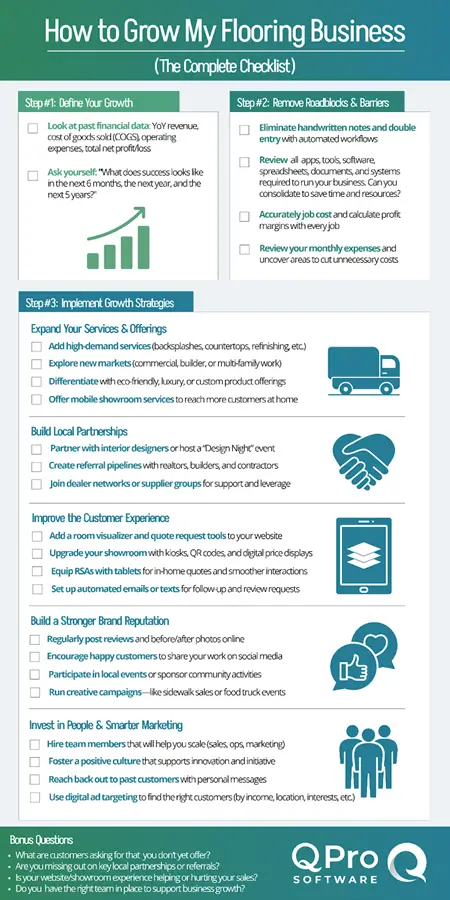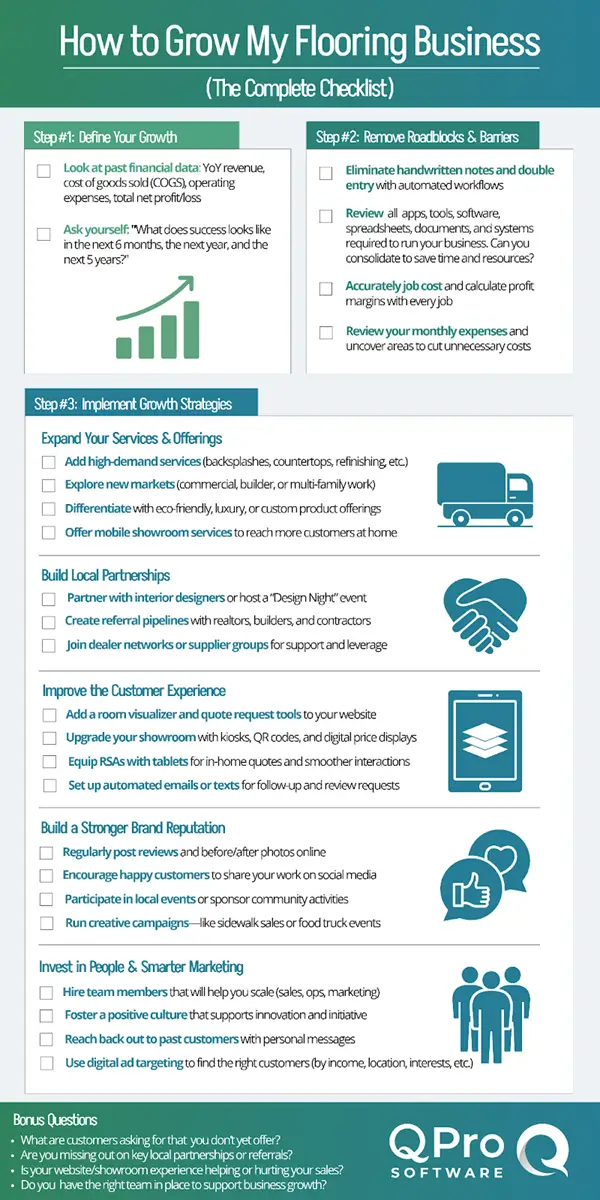Table of Contents:
Step #1: Define What "Growth" Means
Step #2: Remove Roadblocks & Barriers That Are Draining Your Time
- Eliminate Manual Tasks That Can Be Automated
- Consolidate Disconnected Systems
- Track Your Margins - Before the Job Starts
- Cut Unnecessary Costs
Step #3: Use Your Freed-Up Time & Profits to Fuel Smart Growth
Running a flooring business isn’t for the faint of heart. Between labor shortages, rising costs from inflation and tariffs, and tough competition from big-box stores, it’s easy to feel overwhelmed.
But here’s the truth: there will always be challenges—no matter the year. That doesn’t mean you can’t grow. With the right systems and strategies in place, this year can still be a year of growth for your flooring business.
Step #1: Define What "Growth" Means
If you’re wondering how to grow your flooring business, the first step is to define what growth looks like for you. More sales don’t always mean more profit—especially if you're selling at thin margins or overspending on labor, inventory, or overhead.
To grow the right way, you need visibility into your numbers.
That starts with having the right tools and systems in place—so you can get accurate monthly financial statements. A P&L (Profit & Loss) report should show you:
- Total revenue
- Cost of goods sold
- Operating expenses (rent, labor, etc.)
- Net profit or loss
Without clear, accurate, up-to-date numbers, you’re just flying blind.
That’s where flooring-specific business software like QFloors or QPro can make a difference. It helps you track jobs, margins, and performance in real time.
Questions to ask yourself:
- What does success look like in the next 6 months? The next year? The next 5 years?
- Are you looking to grow your team? Expand into new locations?
- What percentage of net profit increase are you aiming for in 2025?
Step #2: Remove Roadblocks & Barriers That Are Draining Your Time
If you’re trying to figure out how to grow your flooring business, there’s one major obstacle dealers often face: not enough time.
You might have big plans—new services, expansion, hiring, or marketing—but if your days are swallowed up by busywork, those growth goals will stay stuck on the back burner.
Before you can successfully grow your flooring business, you need to remove the barriers draining your time and profits. Here are some common roadblocks—and how to overcome them:
Eliminate Manual Tasks That Could Be Automated
The Problem:
If you're still tracking sales orders, inventory, or job details using paper or spreadsheets, you’re likely facing inefficiencies, errors, and team miscommunication. Digging through files or sticky notes to find key details wastes time and increases the risk of mistakes.
The Solution:
Invest in a flooring business software like QPro or QFloors that stores your quotes, leads, job histories, product catalogs, and financials in one place. Automation can help pass information between departments—without copy-pasting or retyping—saving time and reducing human error.
Consolidate Disconnected Systems
The Problem:
Using too many tools (spreadsheets, calendars, quoting software, job tracking apps, etc.) creates confusion and duplication. If you constantly have 30+ tabs open and keep re-entering the same information in multiple places, you know too well the frustration of a disconnected system.
The Solution:
Take inventory of all the software and tools you use. Could one integrated system replace five? Flooring business management software can centralize operations and reduce manual entry. Look for platforms with strong integrations to minimize the time spent moving data between tools.
Track Your Margins—Before the Job Starts
The Problem:
If you're not calculating job costs and margins as you create quotes, you may be pricing jobs too low—causing you to lose money without realizing it. Overhead costs like labor, freight, and taxes can quickly eat away at your profit if not accounted for.
The Solution:
Build profit margin tracking into your quoting process. Use software that provides accurate, real-time job costing, so you can ensure every job is profitable before the customer signs the proposal.
Cut Unnecessary Costs
The Problem:
Small expenses often fly under the radar—monthly subscriptions, outdated tools, unnecessary materials, and inefficient processes can quietly eat away at your profits. If you’re spending without seeing a clear return, it’s time for a closer look.
The Solution:
Take time to audit your monthly expenses and identify areas where money is slipping through the cracks. Are your marketing dollars generating qualified leads? Could you negotiate better rates for materials or credit card processing? Even minor adjustments—like canceling unused services, taking advantage of all of your discounts, or streamlining supply orders—can improve your cash flow and free up funds to reinvest in meaningful growth.
Questions to ask yourself:
- What tasks am I manually typing or writing out that could be automated?
- Am I switching between too many tools that could be consolidated?
- Am I reviewing job costs before closing sales to ensure healthy profit margins?
- What expenses can I cut to increase profitability?
Step #3: Use Your Freed-Up Time & Profits to Fuel Smart Growth
Once you’ve streamlined operations and improved profitability, it’s time to shift your focus toward proactive growth. The flooring dealers who thrive are those who reinvest saved time and money into smart, sustainable strategies.
Here are several high-impact ways to grow your flooring business in 2025:
Expand Your Services & Specialties
Adding new revenue streams or specializations can help you stand out—and give customers more reasons to choose you.
- Offer new services like backsplashes, countertops, cabinets, or refinishing.
- Expand from retail into commercial, multi-family, or builder markets.
- Specialize in high-demand niches like eco-friendly flooring, luxury hardwood, or custom designs.
- Consider offering mobile showroom services to reach more customers at home.
Build Strategic Local Partnerships
You don’t have to find customers alone. Strong local relationships bring affordable, qualified leads that convert.
- Collaborate with interior designers—consider hosting a “Design Night” with free consultations.
- Partner with real estate agents and builders to create a referral pipeline.
- Work with contractors to gain early access to larger projects.
- Join supplier dealer networks or buying groups for added resources.
Improve the Customer Experience
An elevated experience builds trust, closes more sales, and drives referrals.
- Upgrade your website with tools like room visualizers and easy quote request forms.
- Digitize your showroom with video screens, QR-coded price tags, and sleek displays.
- Equip your sales team with tablets and apps for seamless in-home quotes and showroom tours.
- Automate customer communication with follow-up texts, emails, and feedback requests.
Strengthen Your Brand & Reputation
When customers compare businesses, trust is often the deciding factor. It’s vital to consistently showcase your expertise.
- Collect and post customer reviews and before/after photos.
- Ask happy customers to share your work on their own social media accounts.
- Participate in community events, host sales tied to local happenings, or sponsor local causes.
- Promote your business via direct mail, flyers, or creative events (e.g. food trucks in your parking lot).
Invest in People, Culture, and Smarter Marketing
To grow, you need the right team, strong company culture, and marketing that reaches the right people.
- Hire team members who can help you scale—salespeople, project managers, or marketers.
- Encourage employees to bring ideas and take ownership of growth initiatives.
- Send personalized outreach to past customers—thoughtful follow-up goes a long way.
- Use targeted advertising to reach ideal customers by income, location, interests, or life stage.
Questions to ask yourself:
- What do customers ask for that we don’t yet offer?
- Are there untapped referral sources in our community?
- How is our website or showroom experience helping or hurting us?
- Do we have the right team in place to support business growth?

Growth is Possible—If You Set the Right Foundation
Yes, the flooring market comes with challenges—and more will likely emerge in the future. But with the right systems in place, growth is still within reach. To increase profits and expand your business, you’ll need to be open to adapting, streamlining your operations, and letting go of inefficient processes.
The key is building a strong operational foundation. When your business is automated and organized, you free up time and mental bandwidth to focus on what really matters: growing your flooring business.
It won’t always be easy. Stepping outside your comfort zone rarely is. But growth doesn’t happen in a single leap—it happens through small, consistent steps forward. Set realistic goals, celebrate daily wins, and trust the process. Over time, those efforts will compound into real, measurable success.
Looking for the right tools to fuel that growth?
Request a free QPro demo and see how the right flooring software can support your goals and help you grow your flooring business—smarter, faster, and with confidence.

